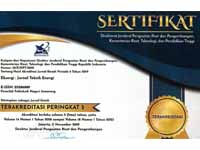Simulation of Automatic Solar Tracker Control System Using Proteus Application
DOI:
https://doi.org/10.32497/eksergi.v20i03.6360Keywords:
Solar tracker, LDR, Proteus simulation, renewable energyAbstract
As a tropical country, Indonesia possesses significant renewable energy potential, particularly from solar and wind sources. However, seasonal variations—such as high solar intensity during the dry season and increased wind speeds during the rainy season—pose challenges to optimizing solar cell utilization. While solar energy presents an ideal solution for clean energy transition, static photovoltaic (PV) systems suffer from efficiency limitations due to their inability to track the sun’s movement. Dual-axis solar trackers can enhance energy efficiency by 25–35% compared to fixed systems, particularly in tropical regions with dynamic solar positioning. However, large-scale physical implementation requires substantial investment, making simulation tools like Proteus essential for computational validation prior to real-world deployment. Proteus facilitates comprehensive modeling of LDR sensors, servo motors, and microcontroller-based control algorithms (e.g., Arduino) in a precise virtual environment. This approach also evaluates the impact of tropical conditions (e.g., humidity, rainfall) on system reliability while optimizing designs to reduce costs. Integrating current research with Proteus simulations offers a robust methodology to accelerate solar tracker adoption in Indonesia.
References
[1] D. F. Silalahi, A. Blakers, M. Stocks, B. Lu, C. Cheng, and L. Hayes, “Indonesia’s vast solar energy potential,” Energies (Basel), vol. 14, no. 17, Sep. 2021, doi: 10.3390/en14175424.
[2] K. R. Oyshei, K. M. S. Hasan, N. Sadat, and Md. A. Hoque, “Comparative analysis of solar module configuration and tracking systems for enhanced energy generation in South Sakucia Union, Bhola, Bangladesh: A software based analysis,” Heliyon, vol. 10, no. 13, p. e33884, Jul. 2024, doi: 10.1016/j.heliyon.2024.e33884.
[3] F. Hidayanti, K. Agusta, and M. Adi, “Solar Cell Research and Its Application,” 2020. [Online]. Available: http://ijses.com/
[4] J. M. Barrios-Sánchez and E. I. Tlapanco-Ríos, “Dual-Axis Solar Tracking System for Enhanced Photovoltaic Efficiency in Tropical Climates,” Sustainability, vol. 17, no. 3, p. 1117, Jan. 2025, doi: 10.3390/su17031117.
[5] K. Asparuhova, D. Shehova, and S. Lyubomirov, “Using Proteus to Support Engineering Student Learning: Microcontroller-Driven Sensors Case Study,” in 2018 IEEE XXVII International Scientific Conference Electronics - ET, IEEE, Sep. 2018, pp. 1–4. doi: 10.1109/ET.2018.8549587.
[6] B. R. Sinaga, “Rancang Bangun Gerbang dengan Menggunakan Kontrol Android Via Bluetooth Berbasis Arduino Uno R3,” Jurnal Pendidikan Sains dan Komputer, vol. 2, no. 2, pp. 2809–476, 2022, doi: 10.47709/jpsk.v2i2.1737.
[7] B. A. Hamad, A. M. T. IBRAHEEM, and A. G. ABDULLAH, “Design and practical implementation of dual-axis solar tracking system with smart monitoring system,” Przeglad Elektrotechniczny, vol. 96, no. 10, pp. 151–155, 2020, doi: 10.15199/48.2020.10.28.
[8] M. Artiyasa, I. Iskandar, and H. Lumbantobing, “Sistem Monitoring PV Menggunakan Simulasi Proteus Untuk Pembelajaran Mahasiswa Teknik Elektro UNsP,” FIDELITY : Jurnal Teknik Elektro, vol. 4, no. 3, pp. 57–61, Sep. 2022, doi: 10.52005/fidelity.v4i3.127.
[9] G. M. Debele and X. Qian, “AUTOMATIC ROOM TEMPERATURE CONTROL SYSTEM USING ARDUINO UNO R3 AND DHT11 SENSOR,” 2020 17th International Computer Conference on Wavelet Active Media Technology and Information Processing (ICCWAMTIP), 2020, doi: 10.1109/ICCWAMTIP51612.2020.9317307/20/$31.00.
[10] A. S. Al-Ezzi and M. N. M. Ansari, “Photovoltaic Solar Cells: A Review,” Applied System Innovation, vol. 5, no. 4, p. 67, Jul. 2022, doi: 10.3390/asi5040067.
[11] A. Dragulinescu and A. M. C. Dragulinescu, “Solar Cell Types and Technologies with Applications in Energy Harvesting,” in 2020 IEEE 26th International Symposium for Design and Technology in Electronic Packaging, SIITME 2020 - Conference Proceedings, Institute of Electrical and Electronics Engineers Inc., Oct. 2020, pp. 323–326. doi: 10.1109/SIITME50350.2020.9292186.
[12] D. Aribowo, G. Priyogi, and S. Islam, “APLIKASI SENSOR LDR (LIGHT DEPENDENT RESISTOR) UNTUK EFISIENSI ENERGI PADA LAMPU PENERANGAN JALAN UMUM,” 2022.
[13] F. Arifin et al., “Aplikasi Sensor LDR (Light Dipendent Resistor) Pada Fitting Lampu Untuk Efisiensi Energi Pada Lampu Penerangan Pondok Pesantren Nurul Jadid Wilayah Zait Bin Tsabit (K),” Prosiding Seminar Hi-Tech, vol. 2, no. 1, 2023, [Online]. Available: https://ejournal.unuja.ac.id/index.php/hitech
[14] A. Hilal and S. Manan, “PEMANFAATAN MOTOR SERVO SEBAGAI PENGGERAK CCTV UNTUK MELIHAT ALAT-ALAT MONITOR DAN KONDISI PASIEN DI RUANG ICU,” Gema Teknologi, vol. 17, no. 2, Aug. 2015, doi: 10.14710/gt.v17i2.8924.
[15] K. Asparuhova, D. Shehova, and S. Lyubomirov, “Using Proteus to Support Engineering Student Learning: Microcontroller-Driven Sensors Case Study,” in 2018 IEEE XXVII International Scientific Conference Electronics - ET, IEEE, Sep. 2018, pp. 1–4. doi: 10.1109/ET.2018.8549587.
Downloads
Published
Issue
Section
License
Copyright (c) 2024 Erwan Tri Efendi, Bayu Setyo Wibowo, Dhiyaussalam Dhiyaussalam, Arum Kusuma Wardhany, Arifin Wibisono

This work is licensed under a Creative Commons Attribution 4.0 International License.
Authors who publish with this journal agree to the following terms:Authors retain copyright and grant the journal right of first publication with the work simultaneously licensed under a Creative Commons Attribution License that allows others to share the work with an acknowledgement of the work's authorship and initial publication in this journal.
Authors are able to enter into separate, additional contractual arrangements for the non-exclusive distribution of the journal's published version of the work (e.g., post it to an institutional repository or publish it in a book), with an acknowledgement of its initial publication in this journal.
Authors are permitted and encouraged to post their work online (e.g., in institutional repositories or on their website) prior to and during the submission process, as it can lead to productive exchanges, as well as earlier and greater citation of published work (See The Effect of Open Access).






